|
Mementos of the Future
by Bob Brooke
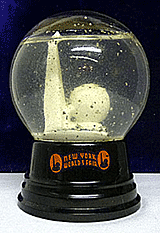 Options
are endless when it comes to worlds fair collectibles. Since the 1850s
there have been over 100 world’s fairs. While souvenirs of the earliest
fairs are difficult to find, there are plenty from the fairs of the
1890s onward. As fairs evolved into the 20th century, they produced
thousands of items—many produced as souvenirs and others as part of the
fair infrastructure. Options
are endless when it comes to worlds fair collectibles. Since the 1850s
there have been over 100 world’s fairs. While souvenirs of the earliest
fairs are difficult to find, there are plenty from the fairs of the
1890s onward. As fairs evolved into the 20th century, they produced
thousands of items—many produced as souvenirs and others as part of the
fair infrastructure.
When it comes to World’s Fair collectibles, some of the most popular
World’s Fairs were: London in 1851, Paris in 1855 and 1889, Philadelphia
in 1876, Chicago in 1893, St. Louis in 1904, San Francisco in 1915, New
York in 1939 and 1964, Seattle in 1962, and Montreal in 1967.
The first world’s fair recognized by the Bureau of International
Expositions was the Great Exhibition of 1851, held in and around a glass
structure called the Crystal Palace in London’s Hyde Park. Thirty-two
countries participated in the almost six-month-long event, which
attracted more than six million visitors. Few souvenirs of that event
remain.
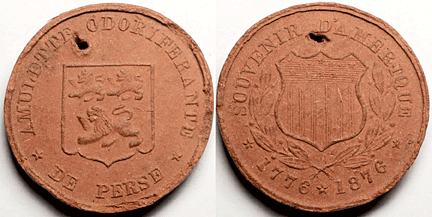 The
United States hosted its first official exposition in 1876 to mark the
country’s centennial. Held in Philadelphia, the Centennial Exposition
offered visitors all sorts of keepsakes, from inkwells and sewing boxes
to metal Liberty Bell paperweights and stereoviews of everything from
Tiffany vases to the steel turret salvaged from the famous Civil War
vessel "The Monitor." The
United States hosted its first official exposition in 1876 to mark the
country’s centennial. Held in Philadelphia, the Centennial Exposition
offered visitors all sorts of keepsakes, from inkwells and sewing boxes
to metal Liberty Bell paperweights and stereoviews of everything from
Tiffany vases to the steel turret salvaged from the famous Civil War
vessel "The Monitor."
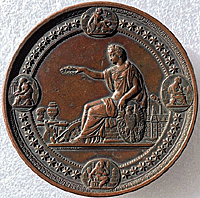 Toward
the end of the century, Chicago hosted a second U.S. exposition in1893.
Called the Columbian World’s Fair, the spectacle celebrated the 400th
anniversary of the arrival of Christopher Columbus in the New World. In
addition to the china, glassware, prints, postcards, badges, medals, and
charms produced for the Fair, collectors of world’s fair memorabilia
seek out the official U.S. coins minted prior to the event as a
fundraiser for it. Toward
the end of the century, Chicago hosted a second U.S. exposition in1893.
Called the Columbian World’s Fair, the spectacle celebrated the 400th
anniversary of the arrival of Christopher Columbus in the New World. In
addition to the china, glassware, prints, postcards, badges, medals, and
charms produced for the Fair, collectors of world’s fair memorabilia
seek out the official U.S. coins minted prior to the event as a
fundraiser for it.
Paris held its third major world’s fair in 1900, located around the
Eiffel Tower, as was the previous fair. Souvenir plates depicted guests
from all over the world attending the fair and the structures built for
it, as well as lists of scheduled events, such
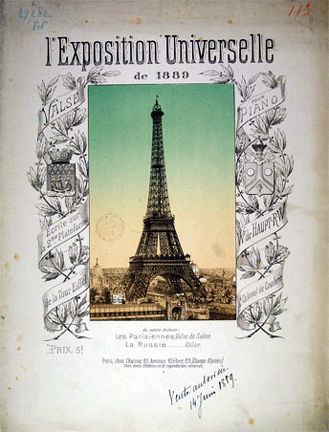 as
a performance by Sarah Bernhardt. Visitors could also take home souvenir
photo portfolios, postcards, and stereoviews of the fairgrounds.
American the Pan-American Exposition in Buffalo, New York, in 1901, came
coins, pinbacks, and shot glasses. as
a performance by Sarah Bernhardt. Visitors could also take home souvenir
photo portfolios, postcards, and stereoviews of the fairgrounds.
American the Pan-American Exposition in Buffalo, New York, in 1901, came
coins, pinbacks, and shot glasses.
The Louisiana Purchase Exposition, held in St. Louis in 1904, offered
the usual array of ceramic plates and glass and metal cups to visitors,
and it gained greater notoriety in 1944 when “Meet Me in St. Louis,”
starring Judy Garland, hit movie theaters. In 1909, Seattle hosted its
first world’s fair when the Alaska-Yukon-Pacific Exposition was held on
what is now the campus of the University of Washington. Tourists took
home Staffordshire plates, aluminum cigar holders, and beribboned
pinbacks.
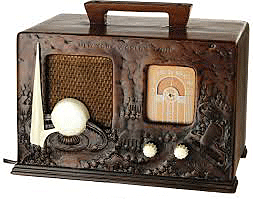 The
end of the 1930s witnessed probably the greatest world’s fair of the
20th century in New York. The “World of Tomorrow” was an icon of
late-Great Depression optimism, symbolized by the 700-foot-tall Trylon
and its adjacent 200-foot-diameter Perisphere, which housed a miniature
city of the future dubbed “Democracity.” Fiesta made plates depicting a
potter at his wheel, there were numerous types of hand-painted Nippon
ware to choose from, and there were even knockoffs of Wedgwood and
Lalique. RCA made a commemorative radio, Remington did the same with a
portable typewriter, and Macy’s sold Dutch Girl dolls. Lighters,
compacts, and ashtrays were also popular, as were coins, pins, buttons,
badges, and pocket knives. The
end of the 1930s witnessed probably the greatest world’s fair of the
20th century in New York. The “World of Tomorrow” was an icon of
late-Great Depression optimism, symbolized by the 700-foot-tall Trylon
and its adjacent 200-foot-diameter Perisphere, which housed a miniature
city of the future dubbed “Democracity.” Fiesta made plates depicting a
potter at his wheel, there were numerous types of hand-painted Nippon
ware to choose from, and there were even knockoffs of Wedgwood and
Lalique. RCA made a commemorative radio, Remington did the same with a
portable typewriter, and Macy’s sold Dutch Girl dolls. Lighters,
compacts, and ashtrays were also popular, as were coins, pins, buttons,
badges, and pocket knives.
Of the four world’s fairs held in North America in the 1960s—The Century
21 Exposition in Seattle in 1962, a second world’s fair in New York in
1964, Expo 67 in Montreal in 1967, and HemisFair ’68 in San Antonio in
1968—the expos in Seattle and Montreal left the biggest marks. The image
of Seattle’s Space Needle can be found on stamps, medals, plates,
glasses, spoons, lamps, and pens.
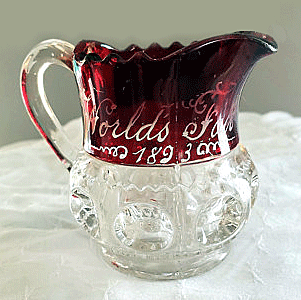 One
of the most popular souvenirs of worlds fairs in the late 19th and early
20th century was the souvenir glass cream pitcher. Most pitchers from
fairs of that era were mass-produced glass mini pitchers in a variety of
shapes. Vendors sold them from small kiosks or stands. Fairgoers could
have their pitchers engraved with the name of the fair and date in
script while they waited. The pressed glass pitchers had molded crystal
lower halves with ruby flashing of glass at top. One
of the most popular souvenirs of worlds fairs in the late 19th and early
20th century was the souvenir glass cream pitcher. Most pitchers from
fairs of that era were mass-produced glass mini pitchers in a variety of
shapes. Vendors sold them from small kiosks or stands. Fairgoers could
have their pitchers engraved with the name of the fair and date in
script while they waited. The pressed glass pitchers had molded crystal
lower halves with ruby flashing of glass at top.
The flashed glass pitcher was the most popular souvenir of the day.
Cheap and attractive, the form could be found at just about any public
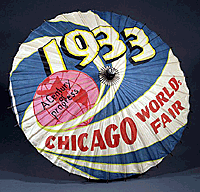 gathering.
Today, depending on condition and script, they sell for $15-$45. Ceramic
pitchers, on the other hand, were more expensive at the fairs, so fewer
are available to collectors. gathering.
Today, depending on condition and script, they sell for $15-$45. Ceramic
pitchers, on the other hand, were more expensive at the fairs, so fewer
are available to collectors.
The 1933-1934 Chicago Century of Progress fair remains one of the most
collected of all World's Fairs. Just about everyone who entered the
lakefront site had to bring something home. Fairgoers bought all sorts
of items, from parasols to trays to souvenir spoons to posters.
What to Look For
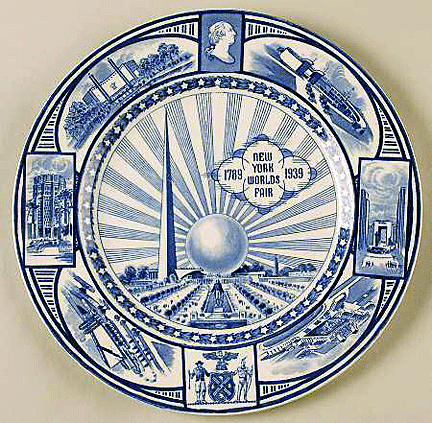 Some
valuable World’s Fair collectibles include: an admission ticket to the
Centennial Expo held in Philadelphia in 1876, ferris wheel toys from the
1893 World Columbian Exposition in Chicago where George Ferris’ famous
amusement ride debuted, an Ingersoll pocket watch with the Cascades
pictured on the dial from the 1904 Louisiana Purchase Exhibition in St.
Louis, a ruby glass cut to clear souvenir cup with the city and year of
the World’s Fair embossed on the surface, a Jim Beam bottle in the shape
of the landmark Space Needle which was erected for the World’s Fair held
in Seattle, Washington in 1962, and the World’s Fair board game
highlighting the famous Perisphere and other attractions of the 1964
World’s Fair in New York City. Some
valuable World’s Fair collectibles include: an admission ticket to the
Centennial Expo held in Philadelphia in 1876, ferris wheel toys from the
1893 World Columbian Exposition in Chicago where George Ferris’ famous
amusement ride debuted, an Ingersoll pocket watch with the Cascades
pictured on the dial from the 1904 Louisiana Purchase Exhibition in St.
Louis, a ruby glass cut to clear souvenir cup with the city and year of
the World’s Fair embossed on the surface, a Jim Beam bottle in the shape
of the landmark Space Needle which was erected for the World’s Fair held
in Seattle, Washington in 1962, and the World’s Fair board game
highlighting the famous Perisphere and other attractions of the 1964
World’s Fair in New York City.
Obviously, collector seek out the most valuable World’s Fair items which
highlight the most famous features of a particular World’s Fair. Objects
that recall the immense project of the fairgrounds and important
landmarks that debuted at the fair like the Eiffel Tower and such are
most desirable on the collectibles market for a few hundred dollars to
several tens of thousands of dollars.
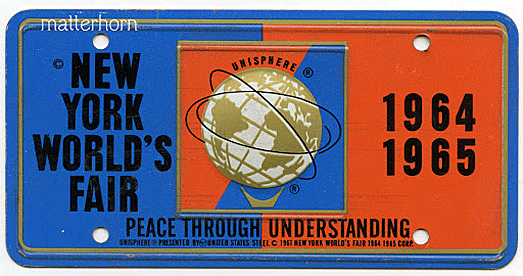
Beginning collectors should look for unique, unusual, hard to come by,
or exotic World’s Fair collectibles first introduced at a specific
World’s Fair like ice cream cone advertisements, Tiffany stained glass
lamps, Eiffel Tower snow globes, etc. They also collect those World’s
Fair collectibles that feature a specific host city or focus on a
particular innovation or specialty attraction.
< Back
to Collectibles Archives
Next Article > |
